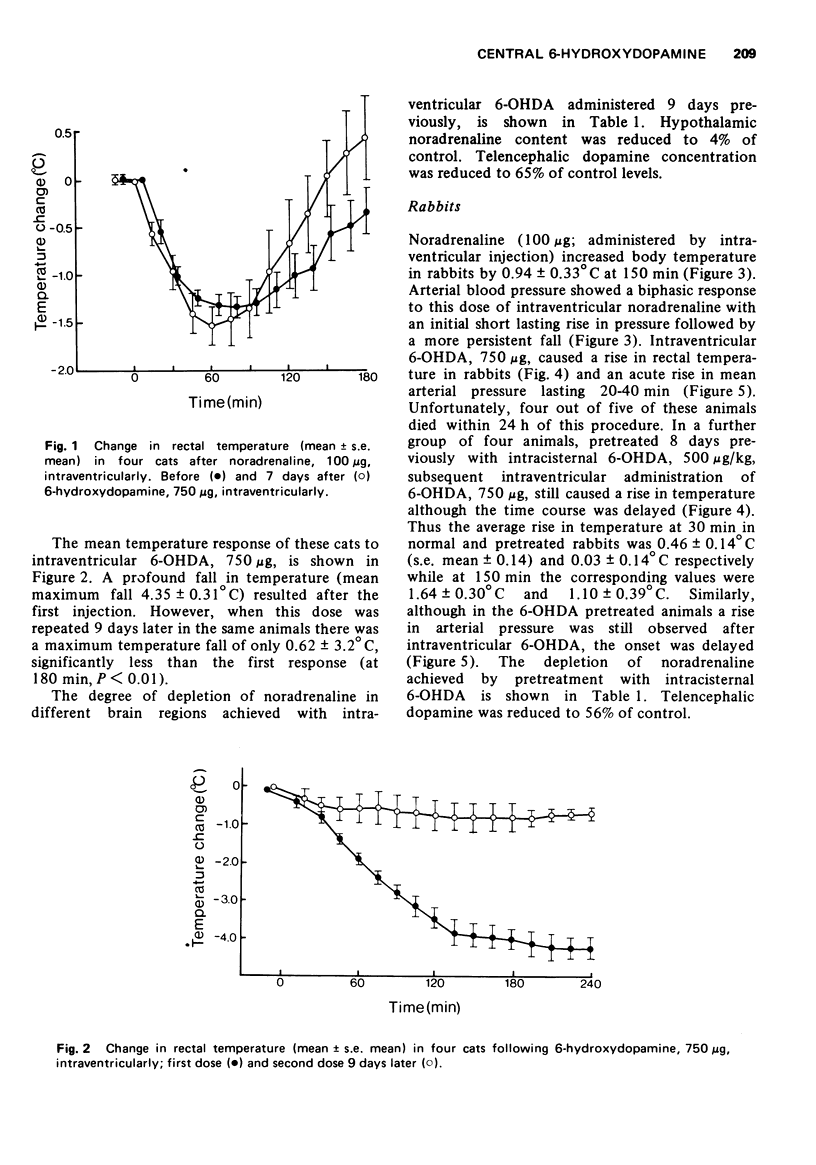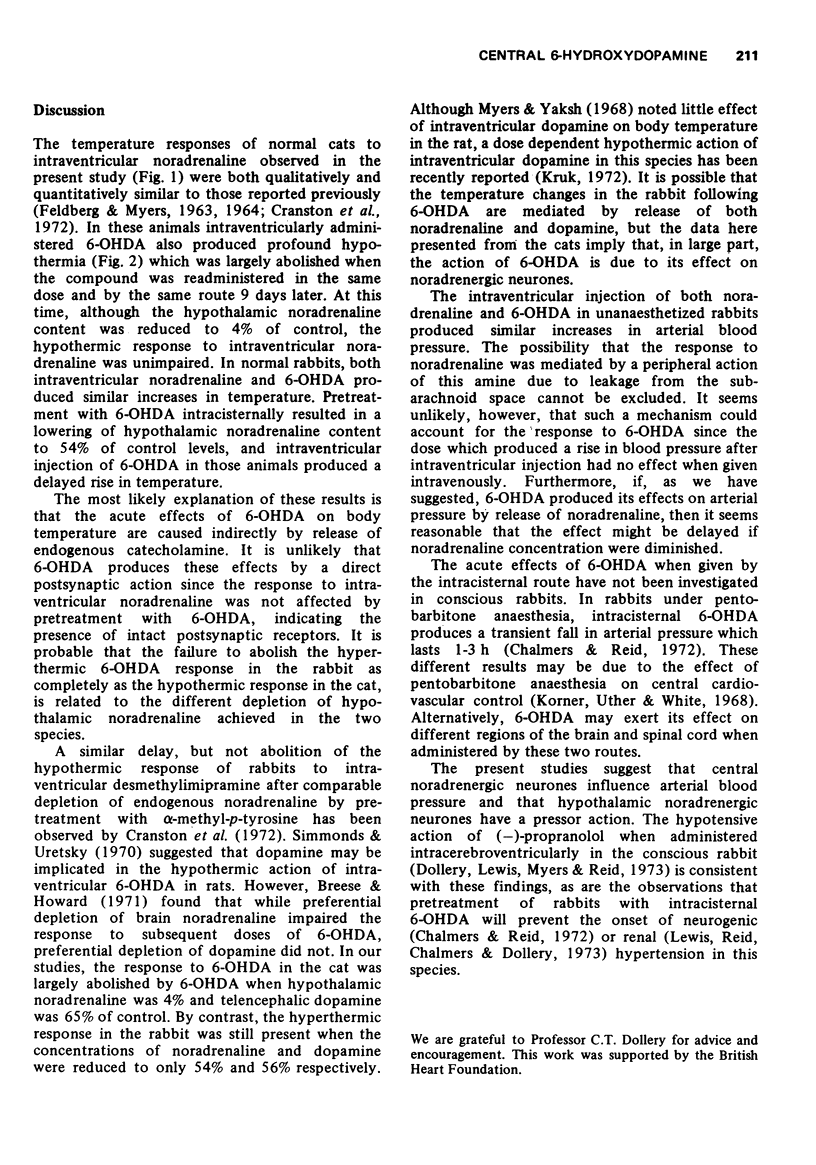Abstract
1 In unanaesthetized cats, the administration of 6-hydroxydopamine (6-OHDA), 750 μg, via the lateral cerebral ventricle produced a pronounced fall in rectal temperature but only a slight fall when repeated 7 days later. At this time hypothalamic noradrenaline concentration had diminished to 4% of control.
2 In these animals, the hypothermic response to exogenous noradrenaline, 100 μg, given via the same route was uninfluenced by pretreatment with 6-OHDA.
3 In unanaesthetized rabbits, intraventricular noradrenaline, 100 μg, produced a rise in rectal temperature and a biphasic effect on arterial pressure, a rise lasting 30 min followed by a fall.
4 Intraventricular 6-OHDA, 750 μg, in unanaesthetized rabbits produced a rise in body temperature and a rise in arterial pressure. The same dose given to rabbits depleted of central noradrenaline with central 6-OHDA produced rises in body temperature and arterial pressure of similar magnitude, but of slower onset.
5 These results suggest that intraventricular 6-OHDA releases noradrenaline from central neurones and that these neurones subserve thermoregulatory functions in both species. In the rabbit, central noradrenergic neurones can raise arterial pressure.
Full text
PDF





Selected References
These references are in PubMed. This may not be the complete list of references from this article.
- Breese G. R., Howard J. L. Effect of central catecholamine alterations on the hypothermic response to 6-hydroxydopamine in desipramine treated rats. Br J Pharmacol. 1971 Nov;43(3):671–674. doi: 10.1111/j.1476-5381.1971.tb07197.x. [DOI] [PMC free article] [PubMed] [Google Scholar]
- Brittain R. T., Handley S. L. Temperature changes produced by the injection of catecholamines and 5-hydroxytryptamine into the cerebral ventricles of the conscious mouse. J Physiol. 1967 Oct;192(3):805–813. doi: 10.1113/jphysiol.1967.sp008332. [DOI] [PMC free article] [PubMed] [Google Scholar]
- CARLSSON A., WALDECK B. A fluorimetric method for the determination of dopamine (3-hydroxytyramine). Acta Physiol Scand. 1958 Dec 15;44(3-4):293–298. doi: 10.1111/j.1748-1716.1958.tb01628.x. [DOI] [PubMed] [Google Scholar]
- Chalmers J. P., Reid J. L. Participation of central noradrenergic neurons in arterial baroreceptor reflexes in the rabbit. A study with intracisternally administered 6-hydroxydopamine. Circ Res. 1972 Nov;31(5):789–804. doi: 10.1161/01.res.31.5.789. [DOI] [PubMed] [Google Scholar]
- Cooper K. E., Cranston W. I., Honour A. J. Effects of intraventricular and intrahypothalamic injection of noradrenaline and 5-HT on body temperature in conscious rabbits. J Physiol. 1965 Dec;181(4):852–864. doi: 10.1113/jphysiol.1965.sp007801. [DOI] [PMC free article] [PubMed] [Google Scholar]
- Dollery C. T., Lewis P. H., Myers M. G., Reid J. L. Central hypotensive effect of propranolol in the rabbit. Br J Pharmacol. 1973 Jun;48(2):343P–343P. [PMC free article] [PubMed] [Google Scholar]
- FELDBERG W., MYERS R. D. A NEW CONCEPT OF TEMPERATURE REGULATION BY AMINES IN THE HYPOTHALAMUS. Nature. 1963 Dec 28;200:1325–1325. doi: 10.1038/2001325a0. [DOI] [PubMed] [Google Scholar]
- FELDBERG W., MYERS R. D. EFFECTS ON TEMPERATURE OF AMINES INJECTED INTO THE CEREBRAL VENTRICLES. A NEW CONCEPT OF TEMPERATURE REGULATION. J Physiol. 1964 Sep;173:226–231. doi: 10.1113/jphysiol.1964.sp007454. [DOI] [PMC free article] [PubMed] [Google Scholar]
- FELDBERG W., SHERWOOD S. L. Injections of drugs into the lateral ventricle of the cat. J Physiol. 1954 Jan;123(1):148–167. doi: 10.1113/jphysiol.1954.sp005040. [DOI] [PMC free article] [PubMed] [Google Scholar]
- Feldberg W., Hellon R. F., Lotti V. J. Temperature effects produced in dogs and monkeys by injections of monoamines and related substances into the third ventricle. J Physiol. 1967 Aug;191(3):501–515. doi: 10.1113/jphysiol.1967.sp008264. [DOI] [PMC free article] [PubMed] [Google Scholar]
- Findlay J. D., Thompson G. E. The effect of intraventricular injections of noradrenaline, 5-hydroxytryptamine, acetylcholine and tranylcypromine on the ox (Bos taurus) at different environmental temperatures. J Physiol. 1968 Feb;194(3):809–816. doi: 10.1113/jphysiol.1968.sp008436. [DOI] [PMC free article] [PubMed] [Google Scholar]
- Korner P. I., Uther J. B., White S. W. Circulatory effects of chloralose-urethane and sodium pentobarbitone anaesthesis in the rabbit. J Physiol. 1968 Dec;199(2):253–265. doi: 10.1113/jphysiol.1968.sp008652. [DOI] [PMC free article] [PubMed] [Google Scholar]
- Kruk Z. L. The effect of drugs acting on dopamine receptors on the body temperature of the rat. Life Sci I. 1972 Sep 15;11(18):845–850. doi: 10.1016/0024-3205(72)90100-2. [DOI] [PubMed] [Google Scholar]
- MCCUBBIN J. W., KANEKO Y., PAGE I. H. Ability of serotonin and norepinephrine to mimic the central effects of reserpine on vasomotor activity. Circ Res. 1960 Jul;8:849–858. doi: 10.1161/01.res.8.4.849. [DOI] [PubMed] [Google Scholar]
- Simmonds M. A., Uretsky N. J. Central effects of 6-hydroxydopamine on the body temperature of the rat. Br J Pharmacol. 1970 Dec;40(4):630–638. doi: 10.1111/j.1476-5381.1970.tb10643.x. [DOI] [PMC free article] [PubMed] [Google Scholar]
- Thoenen H., Tranzer J. P. Chemical sympathectomy by selective destruction of adrenergic nerve endings with 6-Hydroxydopamine. Naunyn Schmiedebergs Arch Exp Pathol Pharmakol. 1968;261(3):271–288. doi: 10.1007/BF00536990. [DOI] [PubMed] [Google Scholar]
- von EULER U., LISHAJKO F. Improved technique for the fluorimetric estimation of catecholamines. Acta Physiol Scand. 1961 Apr;51:348–355. doi: 10.1111/j.1748-1716.1961.tb02128.x. [DOI] [PubMed] [Google Scholar]


